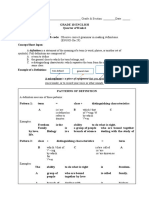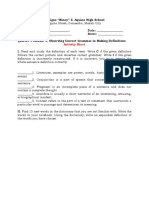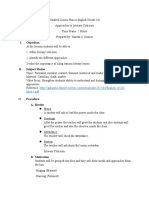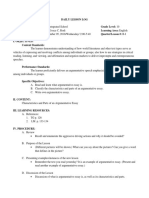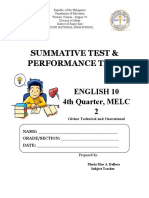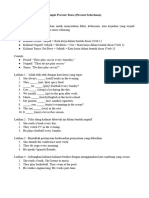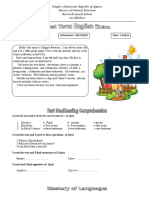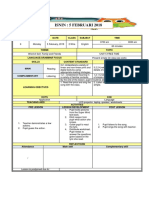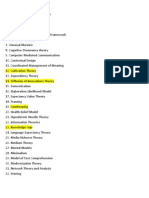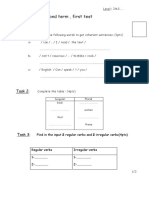Professional Documents
Culture Documents
Lesson Plan Grade 10 Melc 4
Lesson Plan Grade 10 Melc 4
Uploaded by
Mark12 PerezOriginal Description:
Copyright
Available Formats
Share this document
Did you find this document useful?
Is this content inappropriate?
Report this DocumentCopyright:
Available Formats
Lesson Plan Grade 10 Melc 4
Lesson Plan Grade 10 Melc 4
Uploaded by
Mark12 PerezCopyright:
Available Formats
LESSON PLAN IN TEACHING GRADE 10
OBSERVE CORRECT GRAMMAR IN MAKING DEFINITIONS
by: Eugene R. Porque
Practice Teacher
Pototan National Comprehensive High School
Pototan, Iloilo
MOST ESSENTIAL LEARNING COMPETENCY
EN10G-IIa-29 Observe correct grammar in making definitions.
I. OBJECTIVES
At the end of the lesson, the students are able to:
a. identify the parts of a definition;
b. determine the patterns of a definition; and
c. observe correct grammar in making definitions.
II. CONTENT OR SUBJECT MATTER
Topic: Observe Correct Grammar in Making Definitions (Quarter 4, MELC 4)
Materials: laptop and/or smartphone, paper, and pen,
III. LEARNING EXPERIENCE
A. Motivation
Question: How do you know that a definition is grammatically correct?
B. Presentation
DEFINITION
-is an explanation of the meaning of a word, phrase, etc. It is a
statement that defines a word, phrase, etc. and that describes what
something is. Also, it answers the question, “What is x?”
-is used when a message or text contains a term that may be
unfamiliar to the readers or listeners and that may be a key to their
understanding.
FORMAL DEFINITION
-is based upon a concrete, logical pattern that includes information
in a minimum amount of space.
THREE PARTS OF FORMAL DEFINITION
1. Term- is a word or phrase to be defined.
2. Genus (Class or General Class)- refers to the specific class or
category that the term is connected to.
3. Differentia (Differentiating Characteristics)- refers to the set of
characteristics separating the term from other elements in its class.
Definition Term Genus Differentia
(Class or (Differentiating
General Class) Characteristics)
1. English refers to a English a language serves as a medium of
language that serves as a communication
medium of communication.
2. Pronoun is a part of Pronoun a part of speech takes the place of a
speech that takes the place noun
of a noun.
TWO PATTERNS OF DEFINITION
1. T=G+D
T - Term
G - Genus
D - Differentia
= - is, are, refer(s) to, etc.
+ - that, of, for, etc.
Example:
Research is the systematic investigation that studies
materials and sources in order to establish facts and reach
new conclusions.
T - Research
+ - is
G – a systematic investigation
= - that
D - studies materials and sources in order to establish
facts and reach new conclusions
2. G+D=T
G - Genus
D - Differentia
T - Term
+ - that, of, for, etc.
= - is, is called, refer(s) to, etc.
Example:
A systematic investigation that studies materials and
sources in order to establish facts and reach new conclusions
is called research.
G - A systematic investigation
D - studies materials and sources in order to establish
facts and reach new conclusions
T - research
+ - that
= - is called
C. Activities
Activity 1: IDENTIFY THE PART OF A DEFINITION
Directions: Read each definition. Identify what part of definition is
underlined.
1. Students are a group of people who are enrolled in an
educational institution.
2. The pieces of information that are collected through
observation are called data.
3. Internet pertains to a global computer network that
provides a variety of information and communication facilities.
Activity 2: DETERMINE THE PATTERN OF A DEFINITION
Directions: Read each definition. Determine what pattern of definition
is used.
1. Mathematics is the science that deals with the logic of
shape, quantity, and arrangement.
2. A brief statement of essential information in a document or
presentation is called abstract.
Activity 3: MAKE A DEFINITION BY OBSERVING CORRECT
GRAMMAR
Directions: Make a definition for each term by observing correct
grammar. Use the different parts of a definition. After making a
definition, say the pattern you use or follow.
1. PHILIPPINES
2. PRESIDENT
3. FILIPINO
4. EDUCATION
5. CELLULAR PHONES
Process Questions:
1. How did you find the activities?
2. What have you learned or realized in our lesson?
D. Generalization
1. How many parts does a definition have?
2. What are the parts of a definition?
3. How many patterns does a definition have?
4. What are the patterns of definition?
5. Is observing correct grammar in making definitions important?
6. Why is observing correct grammar in making definitions important?
IV. Evaluation
Directions: Read and analyze the statements. Write TRUE if the statement is
correct and FALSE if otherwise.
1. Definition is an explanation of the meaning of a word, phrase,
etc. It is a statement that defines a word, phrase, etc. and that
describes what something is. Also, it answers the question,
“What is x?”
2. Definition is not a key to understanding.
3. Formal definition is based upon a concrete, logical pattern that
includes information in a minimum amount of space.
4. Term, genus, and differentia are the three parts of definition.
5. Any of the two patterns of definition can be used.
6. Psychology is a branch of science that deals with the study of
human behaviour. The underlined word is genus.
7. Observing correct grammar in making definitions is not a must.
8. All words ending in ‘s’ are plural in form.
9. The statement is grammatically correct when there is no error.
10. In making definitions, subject-verb agreement should be given
less regard.
V. Agreement
Instructions: Using a one whole sheet of paper, write ten terms and give their
definitions. Underline and label the parts, and give the pattern you use.
You might also like
- Lesson Exemplar For Grade 10 - Technical and Operational DefinitionDocument5 pagesLesson Exemplar For Grade 10 - Technical and Operational DefinitionMam Shiellan Francisco100% (3)
- Lesson Plan English10 q3Document4 pagesLesson Plan English10 q3Johnny Xavier Dee100% (2)
- Technical and Operational Definition Detailed Lesson PlanDocument2 pagesTechnical and Operational Definition Detailed Lesson PlanLadyvirdi CarbonellNo ratings yet
- Lesson Exemplar in English 10 4th QuarterDocument5 pagesLesson Exemplar in English 10 4th QuarterHellen DeaNo ratings yet
- Lesson Plan in English - Expanded Definitions of WordsDocument7 pagesLesson Plan in English - Expanded Definitions of WordsDela Cruz Liza Mariz100% (17)
- Detailed Lesson Plan in English 10 Quarter 4Document9 pagesDetailed Lesson Plan in English 10 Quarter 4Cristopher A. MorgadesNo ratings yet
- Expanded Definition of Words DLPDocument9 pagesExpanded Definition of Words DLPmic lobrinNo ratings yet
- En10V-Iia-13.9 En10G-Iia-29:: Powerpoint Presentation About Technical and Operational DefinitionsDocument5 pagesEn10V-Iia-13.9 En10G-Iia-29:: Powerpoint Presentation About Technical and Operational DefinitionsLj You71% (7)
- Lesson Exemplar For Grade 10 - Movie ReviewDocument3 pagesLesson Exemplar For Grade 10 - Movie ReviewMam Shiellan Francisco100% (1)
- English Lesson Plan - Grade 10 4th QuarterDocument5 pagesEnglish Lesson Plan - Grade 10 4th QuarterKate Guico100% (4)
- Lesson Plan in English 10 - COT2Document6 pagesLesson Plan in English 10 - COT2Angel Rose Timtim100% (3)
- G10-MELC5-WEEK 5-Lesson-ExemplarDocument6 pagesG10-MELC5-WEEK 5-Lesson-ExemplarGinelyn MaralitNo ratings yet
- Quiz DemoDocument1 pageQuiz DemoLOIDA ALMAZANNo ratings yet
- G1O English Summative Test For 3rd QuarterDocument2 pagesG1O English Summative Test For 3rd QuarterKenneth Del Rosario100% (1)
- The Polar Express PlanningDocument4 pagesThe Polar Express Planningmgm86No ratings yet
- E10 Q4 W6 Observe Correct Grammar in Making Definitions Final 1Document5 pagesE10 Q4 W6 Observe Correct Grammar in Making Definitions Final 1Hanah MocoyNo ratings yet
- Eng. 10 DLP For DemoDocument12 pagesEng. 10 DLP For DemocecilynNo ratings yet
- GRADE 10 DLL For CO2 2022Document8 pagesGRADE 10 DLL For CO2 2022Luis Ilaygan100% (1)
- En10-Iia-13.9: Give Technical and Operational Definitions I. Learning ObjectivesDocument5 pagesEn10-Iia-13.9: Give Technical and Operational Definitions I. Learning ObjectivesIriel Malazarte MalubayNo ratings yet
- Composing An Independent Critique - 4A Detailed Lesson Plan in English 10Document13 pagesComposing An Independent Critique - 4A Detailed Lesson Plan in English 10Dela Cruz Liza Mariz100% (1)
- English 10 Tos (3RD Quarter)Document1 pageEnglish 10 Tos (3RD Quarter)CLARK TERRADO100% (1)
- Quarter 4 Module 4 Observing Correct Grammar in Making DefinitionsDocument1 pageQuarter 4 Module 4 Observing Correct Grammar in Making DefinitionsShadow Gaming YT100% (2)
- Grade 10 English Lesson Exemplar 1st QuarterDocument65 pagesGrade 10 English Lesson Exemplar 1st QuarterXGD.Kaneki100% (2)
- Detailed Lesson Plan in English 10Document13 pagesDetailed Lesson Plan in English 10JOANNA ROSE DELLOMAS-JAVILLONARNo ratings yet
- Observing Correct Grammar in Making DefinitionsDocument31 pagesObserving Correct Grammar in Making DefinitionsAki100% (1)
- Lesson Plan in English 10: MODULE 2: Establishing Solidarity Lesson 1: Sub-ThemeDocument5 pagesLesson Plan in English 10: MODULE 2: Establishing Solidarity Lesson 1: Sub-ThemeMary Anne WenceslaoNo ratings yet
- Technical Terms in Research Lesson PlanDocument7 pagesTechnical Terms in Research Lesson PlanDhelwin Jude GarboNo ratings yet
- Semi Detailed Lesson Plan in English 10Document4 pagesSemi Detailed Lesson Plan in English 10FLORDELIZA TONNo ratings yet
- List of Quarterly Performance Standards Grade 10 Subject/s 1 Quarter 2 Quarter 3 Quarter 4 QuarterDocument4 pagesList of Quarterly Performance Standards Grade 10 Subject/s 1 Quarter 2 Quarter 3 Quarter 4 QuarterApril Alfaro100% (1)
- DLP Quarter 4 Module 4Document5 pagesDLP Quarter 4 Module 4StephanieNo ratings yet
- Department of Education: Detailed Lesson Plan in English 10Document11 pagesDepartment of Education: Detailed Lesson Plan in English 10Jen GonzalesNo ratings yet
- Activity Sheet in English 10: Worksheet No. 2, Quarter 4Document6 pagesActivity Sheet in English 10: Worksheet No. 2, Quarter 4Dhaiiganda100% (3)
- Final Demo Lesson PlanDocument6 pagesFinal Demo Lesson PlanNaneth DomenNo ratings yet
- Q4 Module 4 SDOIN Week 6 Observe Correct Grammar in Making Definitions FINALDocument14 pagesQ4 Module 4 SDOIN Week 6 Observe Correct Grammar in Making Definitions FINALDdeow grtilNo ratings yet
- 10 Reflection Lesson Plan 10 EnglishDocument2 pages10 Reflection Lesson Plan 10 Englishsci Pantallano100% (1)
- Lesson Plan For Grade 10 - OrpheusDocument3 pagesLesson Plan For Grade 10 - OrpheusMam Shiellan Francisco100% (3)
- Lesson 2 Technical and Operational DefinitionDocument6 pagesLesson 2 Technical and Operational DefinitionJunely QuintosNo ratings yet
- Detailed Lesson Plan in Grade 10 - Rhetorical QuestionsDocument10 pagesDetailed Lesson Plan in Grade 10 - Rhetorical QuestionsCarla Jane G. AydallaNo ratings yet
- Department of Education: Detailed Lesson Plan in English 10Document13 pagesDepartment of Education: Detailed Lesson Plan in English 10Jen GonzalesNo ratings yet
- Daily Lesson Log in Characteristics and Parts of An Argumentative EssayDocument2 pagesDaily Lesson Log in Characteristics and Parts of An Argumentative EssayMa-Anne Joyce Rodi100% (2)
- English: Detailed Lesson PlanDocument9 pagesEnglish: Detailed Lesson PlanMark Reynan Manite100% (5)
- G10-MELC4-WEEK 4-Lesson-ExemplarDocument6 pagesG10-MELC4-WEEK 4-Lesson-ExemplarGinelyn MaralitNo ratings yet
- q3 Quiz 3 Structuralist Formalist ApproachDocument3 pagesq3 Quiz 3 Structuralist Formalist ApproachMa. Fe Evangeline SaponNo ratings yet
- DLP 1 English 10 Formalism and StructuralismDocument16 pagesDLP 1 English 10 Formalism and StructuralismAgapito100% (1)
- DLL English 10 For Observation v2Document8 pagesDLL English 10 For Observation v2Jennifer L. Magboo-OestarNo ratings yet
- Technical and Operational DefinitionsDocument11 pagesTechnical and Operational DefinitionsAnne Kenneth Bal-otNo ratings yet
- Grade 10 Week 4 Q1Document3 pagesGrade 10 Week 4 Q1Aristotle Tomas100% (1)
- English 10: Technical Terms Used in ResearchDocument21 pagesEnglish 10: Technical Terms Used in ResearchGinelyn Maralit100% (1)
- Varon, Lara May-Deatailed Lesson PlanDocument8 pagesVaron, Lara May-Deatailed Lesson PlanLara May Varon100% (1)
- Q3 English DLL Week 4Document5 pagesQ3 English DLL Week 4Amy TabaconNo ratings yet
- Lesson Plan ICTDocument3 pagesLesson Plan ICTKaren R. Natad Abayan92% (12)
- English: Detailed Lesson PlanDocument10 pagesEnglish: Detailed Lesson PlanMark Reynan ManiteNo ratings yet
- Technical & Operational Definitions COT 2Document63 pagesTechnical & Operational Definitions COT 2Jovy ArellanoNo ratings yet
- SUMMATIVE ASSESSMENT Q4 Week 2Document7 pagesSUMMATIVE ASSESSMENT Q4 Week 2Em-Em Alonsagay Dollosa100% (1)
- Formalist Approach - Lesson Plan in EnglishDocument17 pagesFormalist Approach - Lesson Plan in EnglishDela Cruz Liza Mariz50% (2)
- Lesson Plan in Grade 10 EssayDocument2 pagesLesson Plan in Grade 10 EssayMire-chan Bacon67% (3)
- DLP English 10 Reader-Response ApproachDocument14 pagesDLP English 10 Reader-Response ApproachAgapitoNo ratings yet
- English: Fourth Quarter - Module 1 Distinguish Technical Terms Used in ResearchDocument14 pagesEnglish: Fourth Quarter - Module 1 Distinguish Technical Terms Used in ResearchVinMoroCipriano67% (3)
- Informative-Persuasive-Argumentative QuizDocument2 pagesInformative-Persuasive-Argumentative Quizgermine.magallonNo ratings yet
- Lesson Plan 4'asDocument6 pagesLesson Plan 4'asDhan GregorioNo ratings yet
- Cot Final 2022Document26 pagesCot Final 2022John Carlo GonzalesNo ratings yet
- Exploring The Reading Struggles of Grade 9 Integrity Students of Dacanlao Gregorio Agoncillo National High SchoolDocument11 pagesExploring The Reading Struggles of Grade 9 Integrity Students of Dacanlao Gregorio Agoncillo National High SchoolJerwienVidalHernandezNo ratings yet
- A Very Good Morning I Bid To The PricipalDocument2 pagesA Very Good Morning I Bid To The PricipalZaim LuqmanNo ratings yet
- Dictionnaire Kurde-Kurdish - English DictionaryDocument288 pagesDictionnaire Kurde-Kurdish - English DictionaryAmjed Db100% (1)
- REACTION PAPER SubmittedDocument3 pagesREACTION PAPER SubmittedMaria Catalina PorcadillaNo ratings yet
- Cutting Edge Upper Intermediate Syllabus Units 1-10Document17 pagesCutting Edge Upper Intermediate Syllabus Units 1-10Emma GololaNo ratings yet
- AbelDocument2 pagesAbelAdeleke SamuelNo ratings yet
- Robert James Dixson Essential Idioms in English With Exercises For Practice and Tests 1987 PDFDocument206 pagesRobert James Dixson Essential Idioms in English With Exercises For Practice and Tests 1987 PDFdaaniel100% (4)
- Lesson Plan: Content: Grammar: Verb Will/ Won't For Predictions and DecisionsDocument8 pagesLesson Plan: Content: Grammar: Verb Will/ Won't For Predictions and DecisionsTiti MadisonNo ratings yet
- MS For 2nd Grading PeriodDocument43 pagesMS For 2nd Grading PeriodJennifer EscalaNo ratings yet
- Module 2 - Teaching Skills and Managing The Classroom Part 1Document48 pagesModule 2 - Teaching Skills and Managing The Classroom Part 1yaliNo ratings yet
- Going For Gold-Intermediate P 4-30Document27 pagesGoing For Gold-Intermediate P 4-30Ana-Maria Gheorghiasa100% (1)
- NarratioNARAYANA ACADAEMY, HYDERABDnDocument9 pagesNarratioNARAYANA ACADAEMY, HYDERABDnspatel1972No ratings yet
- Presentasi Inggris IDocument21 pagesPresentasi Inggris IMaya KomalaNo ratings yet
- Diction For SingingDocument6 pagesDiction For SingingDixie LacuestaNo ratings yet
- 16 Tenses (Definition, Usage, Example, Exercises)Document16 pages16 Tenses (Definition, Usage, Example, Exercises)FajarZainNo ratings yet
- Detailed Lesson Plan in EnglishDocument11 pagesDetailed Lesson Plan in EnglishAnnalyn NicolasNo ratings yet
- Program Guide: Handwriting Without TearsDocument24 pagesProgram Guide: Handwriting Without TearsBalaji PeelaNo ratings yet
- First Term Exam 2ASDocument5 pagesFirst Term Exam 2ASአቸጸ ለከጀNo ratings yet
- Verb Be PracticeDocument1 pageVerb Be PracticeAngel Capichi LunaNo ratings yet
- Brilliant Footsteps Int'L Academy Teacher Abdulrahim Ibrahim Lesson PlanDocument2 pagesBrilliant Footsteps Int'L Academy Teacher Abdulrahim Ibrahim Lesson PlanAbdulRahimNo ratings yet
- Class 6 EnglishDocument66 pagesClass 6 EnglishRahul SinghNo ratings yet
- RPH Kelas Bercantum Dunia Seni VisualDocument2 pagesRPH Kelas Bercantum Dunia Seni VisualNur Naiemah Mohd IbrahimNo ratings yet
- Alphabetic List of TheoriesDocument9 pagesAlphabetic List of TheoriesTahira SafdarNo ratings yet
- Lesson Plan ViiiDocument3 pagesLesson Plan ViiiWinter FlorinNo ratings yet
- Dzexams 2am Anglais d2 20150 34627 PDFDocument2 pagesDzexams 2am Anglais d2 20150 34627 PDFCamélia CamilleNo ratings yet
- Confidence in English Presentation For PDF DownloadDocument16 pagesConfidence in English Presentation For PDF DownloadGatot SandyNo ratings yet
- Source Text Quality in The Translation PDocument280 pagesSource Text Quality in The Translation PMTtrustedwordsNo ratings yet
- Workbook - Literacy - Year 1Document70 pagesWorkbook - Literacy - Year 1amit jaikaran100% (1)
- Types of TestDocument8 pagesTypes of TestNawang Wulan0% (1)















